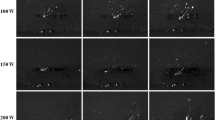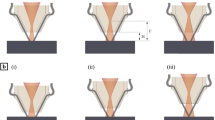Abstract
Selective laser melting (SLM) as a part of 3D printing technology has been a novel industrial manufacturing process nowadays. However, the collection of metal powders emitted from the working plane is significant for the SLM process. The uniformity of the flow passing through the SLM working chamber, which helps collect emitted powders, has been considered as a key solution. In this study, for the purpose of improving the flow uniformity, a blow-to-suction device composed of a trapezoid push nozzle, a working chamber, and a suction tunnel was applied. Various parameters, such as the width of trapezoid push nozzle, the width of suction tunnel, and the nozzle-to-plane distances, were examined experimentally and computationally. Hot-wire velocity measurement and smoke flow visualization were used to verify the reliability of the simulation. Through the results of degree of uniformity (DOU), the momentum exchange between the suction and blow sides plays an important role for producing a uniform flow through the working chamber. In addition, higher suction velocity as well as larger nozzle-to-plane distance result in relatively better uniformity of the flow.
Similar content being viewed by others
References
Ferrar B, Mullen L, Jones E, Stamp R, Sutcliffe CJ (2012) Gas flow effects on selective laser melting (SLM) manufacturing performance. J Mater Process Technol 212:355–364
Dai D, Gu D (2014) Thermal behavior and densification mechanism during selective laser melting of copper matrix composites: simulation and experiments. Mater Des 55:482–491
Marzal F, González E, Miñana A, Baeza A (2002) Analytical model for evaluating lateral capture efficiencies in surface treatment tanks. AIHA J 63:572–577
Marzal F (2002) Influence of push element geometry on the capture efficiency of push-pull ventilation systems in surface treatment tanks. Ann Occup Hyg 46:383–393
Marzal F, González E, Miñana A, Baeza A (2003a) Visualization of airflows in push-pull ventilation systems applied to surface treatment tanks. AIHA J 64:455–460
Marzal F, González E, Miñana A, Baeza A (2003b) Methodologies for determining capture efficiencies in surface treatment tanks. AIHA J 64:604–608
Tseng L-C, Huang RF, Chen C-C, Chang CP (2006) Correlation between airflow patterns and performance of a laboratory fume hood. J Occup Environ Hyg 3:694–706
Chen J-K, Huang RF, Hsin P-Y, Hsu CM, CHen C-W (2012a) Flow and containment characteristics of an air-curtain fume hood operated at high temperatures. Ind Health 50:103–114
Jia-Kun C, Huang RF (2014) Flow characteristics and robustness of an inclined quad-vortex range hood. Ind Health 52:248
Chen JK, Huang RF, Hsin PY (2012b) Dynamic effects on containment of air-curtain fume hood operated with heat source. J Occup Environ Hyg 9:640–652
Chen JK, Huang RF, Hung WL (2013) Flow and leakage characteristics of a sashless inclined air-curtain (sIAC) fume hood containing tall pollutant-generation tanks. J Occup Environ Hyg 10:694–704
Huang RF, Chen JK, Han MJ, Priyambodo Y (2014) Improving flow patterns and spillage characteristics of a box-type commercial kitchen hood. J Occup Environ Hyg 11:238–248
Huang RF, Chen JK, Hung WL (2013) Flow and containment characteristics of a sash-less, variable-height inclined air-curtain fume hood. The Annals of Occupational Hygiene 57:934–952
Huang RF, Lin SY, Jan SY, Hsieh RH, Chen YK, Chen CW et al (2005) Aerodynamic characteristics and design guidelines of push-pull ventilation systems. The Annals of Occupational Hygiene 49:1–15
Bendat JS, Piersol AG (2011) Random data: analysis and measurement procedures. John Wiley & Sons, Hoboken
Hsiao F-B, Lim Y-C, Huang J-M (2010) On the near-field flow structure and mode behaviors for the right-angle and sharp-edged orifice plane jet. Exp Thermal Fluid Sci 34:1282–1289
Author information
Authors and Affiliations
Corresponding author
Rights and permissions
About this article
Cite this article
Wang, WC., Chang, CY. Flow analysis of the laminated manufacturing system with laser sintering of metal powder. Part I: flow uniformity inside the working chamber. Int J Adv Manuf Technol 92, 1299–1314 (2017). https://doi.org/10.1007/s00170-017-0213-5
Received:
Accepted:
Published:
Issue Date:
DOI: https://doi.org/10.1007/s00170-017-0213-5




